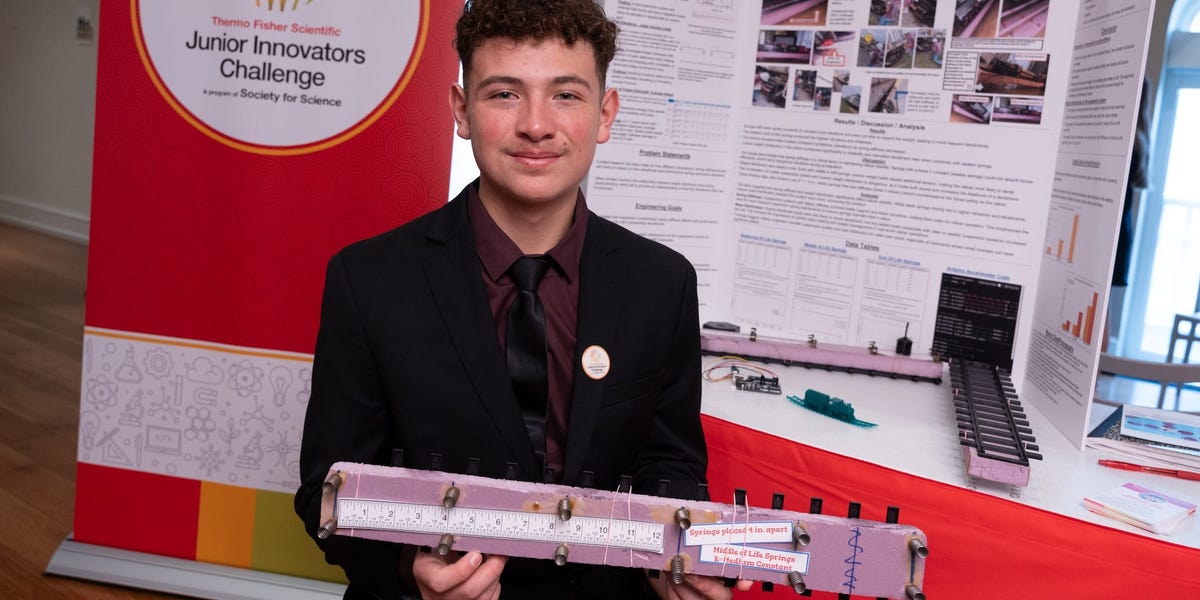This kid just got 10k for saying rail infrastructure is failing due to a lack of maintenance. Specifically the springs at junctions. The main failing here in the US though is that rail maintenance falls to rail companies that have little financial incentive to spend the money on safety. That may be changing, however if the federal government just hands over money with inadequate oversight it will just enrich the companies.
https://www.transportation.gov/briefing-room/fact-sheet-rail-safety
The main failing here in the US though is that rail maintenance falls to rail companies that have little financial incentives to spend the money on safety. That may be changing, however if the federal government just hands over money with inadequate oversight it will just enrich the companies.
Sounds almost as if critical infrastructure should be owned by the public.
But that stinks of communism, doesn’t it… 😄
I can’t wait until Mccarthy has his final death and nobody remembers him anymore…
Need to remember the bastards to remember to piss on their graves.
Much as I understand your sentiment, I think it’s important to remember the people who did horrible things like McCarthy, and use him as a warning to our younger generations who didn’t see the problems they created.
You know, and the grave pissing.
Thanks to how history is being recorded, there’s no chance that he will be forgotten until civilization collapses.
I wouldn’t want history to actually forget any shitty person (or good person) because that makes it way easier for someone with similar ideals to take power again.
It’s more the sentiment.
I have a metaphorical bucket of piss just for Margaret Thatcher. 26+6=1
Given that you yourself are remembering him, you can’t wait until you die / have dementia?
Life is one endless torment after another, soooooooo…
But that stinks of communism, doesn’t it… 😄
Sprinkle a bit of communism on that capitalism.

Tim Roth?
The alternative to communism is drift towards monarchy.
Check out that last link I posted there
Check out that last link I posted there
I wasn’t disagreeing with you, I was making an (hopefully) entertaining comment.
No disagreement inferred! Just playing along and pointing out the last link to those that may not get to it is all. I’ll just go back to doomscrolling election predictions and lamenting our lack of RCV here in the states.
Conrail has left the chat.
if the federal government just hands over money with inadequate oversight it will just enrich the companies.
The worst part of this is that that money is not just wasted, it’s used to lobby politicians to make it worse.
And to be clear, the railroads don’t need more money, back when Biden banned Warren Buffet’s railroad from striking, I did the math, they could afford to double their work force, giving them all half the year off, and pay each one of them 100K/year, and still give the shareholders multiple billions a year.
Absolutely, Robber Barons have been a thing since the rails were laid. It’s a shit system and the main reason we don’t have highspeed rail.
I took Amtrak across the country once. The freight trains are supposed to give priority to the passenger trains so they leave and arrive (mostly) on time, but (outside the NEC) they mostly don’t bother and they’ve never been held to those requirements. Once again, prioritizing “stuff” over people.
Oh it’s simpler than that. They just go around the requirement via loopholes in the agreements. They know they’re required to give priority, so they just make the freight trains too long to fit on the side track on those routes. So if there’s a conflict, the freight train physically cannot get out of the way and the passenger one has to.
They’re prioritizing profits. This is just capitalism working as intended.
Not to mention the inflationary effects of shareholders skimming a set percentage in profits off everything that gets transported over rail. If the government ran it at cost, a huge drag on the economy would be removed.
This is an excellent science fair project. This is not some hidden solution to derailment. The article is devoid of details other than the student observed great variance in truck spring condition and did extensive hypothetical testing to show it can contribute to derailment.
A contributing factor to both frequency and severity of derailment, sure, but a rare initial cause. “Springs” are not outside the considerations of the FRA. If you ever have trouble sleeping, read an FRA derailment report of some non-catastrophic event. Back in the 90s, they went so far as to identify dampening pads - thin plastic plates in the trucks - as the cause of derailment for new heavier intermodal cars. 1" thick plastic that deformed 1/8" under the 250,000lb+ load hit a harmonic frequency that led the trucks to hunt (wobble left and right but never finding a steady center) until the wheels hopped the tracks when entering a curve.
There is a massive test facility in Pueblo, Colorado that has the smartest engineers on the continent working and testing there. There’s straights, curves, a super loop, road crossings, bridges, and even a concrete wall for crashing. They pull rail cars wired more than your road car all to find something, anything in the data. So can resonant frequency be a big contributor to derailment? Yeah, of course. A push becomes a shove 3 cars later and hits some limit. But there’s absolutely no way to predict or control it because every car, ever load, and every piece of track is going to have some unique critical frequency.
And, for the record, the vast majority of those “1300 derailment per day” are low speed (which the article mentions) inside yards when assembling the full train (which the article does not mention). And, while the individual root cause of other derailments is varied, a majority of them are triggered by hard braking. It takes a few minutes for the brake signal to reach the end of the train - it’s a system operated by air pressure that’s used for both signaling and applying brakes. This means when the locomotive slams the brakes, the back of the train is still trying to shove it ahead at full speed long after the locomotive passes the engineer’s original line of sight. This force can be so great it makes the rail roll out form underneath the train. Add in coupler cushions and the train can shorten itself by a few hundred feet under this pressure, shoving couplers to the sides, taking out all the cushion slack, and adding slack towards the front as the middle and rear cars apply the brakes, creating a slinky longer than a mile weighing 140 tons per link. And yes, they’ve certainly “figured out” that empty cars in front of loaded cars is a huge contributing factor to these forces, there’s nothing easy about staying competitive. This platform shows it’s well aware of how much ground rail is losing to truck transportation. By rate and by severity, trucks vastly outweigh trains in terms of damage. The problem is rail failure is much more catastrophic and gets more news. 1 fiery derailment is news. 100 fiery trucks are a statistic. Same as planes. Way safer per passenger mile, way more deadly in failure.
And why do brakes perform so poorly? Because the benefits that come from “interchange” of rail cars between trains, lines, and companies, also comes with a massive interchangeability headache for any changes. I’m not defending the rail industry as if they’re innocent bystanders, but we should all be able to understand the difficulty in trying to convert 1.4 million freight cars to a new system for the first time in, literally, 100 years. Many of these cars reach 50 years of service before being scrapped. Someone owns the rail, someone owns the locomotive, someone owns the freight car base, someone might own the freight car body, and someone owns the cargo. These are often entirely different entities for each. You can’t really do a soft rollout, it’s all or nothing. So here, we sit, with centurion technology. Ironically, the only type that has the same loco and cars every day is the least progressive load - coal trains. It’s runs from the coal processor to the coal plant and back, nothing else. Every other freight train can be diced and hashed multiple times a day.
It’s not all doom and gloom. The East Palestine derailment put “wayside detectors” into the general public’s lexicon. They were talking about relatively simple infrared sensors placed next to the tracks to look for hot bearings. That’s old tech. There are currently massive sheds being implemented filled with cameras that record terabytes of info for each train passing through. It can identify missing bolts, cracked springs, and other failures on the spot. Control is notified and if it’s urgent, the car can be routed to a repair shop or the train can be stopped. There’s even a type with a trolley that rolls along with each truck to image the entire circumference of the wheels, looking for chips and cracks. A stall in the rolling tech doesn’t mean a stall in the industry. Make no mistake, derailment are expensive and companies and trying damn hard to sell solutions to the rail lines.
Passenger trains have their own headaches. Practically each line has its own design engineers reinventing the wheel. While some lines may buy existing designs (notable, the Amtrak Acela that runs from DC to Boston is a French TGV), they have their own design flares (such as doubling the number of trucks for the Acela). These trains do run as consistent units, so they tend to have intercar communication systems and hydraulic brakes, minimizing the overall braking time. That’s why their derailments usually come from speeding or collisions rather than “random” accidents.
I agree that the title is misleading and I couldn’t believe that nothing was done to analyze the problem but you explained it pretty well. Thank you for explaining, all this is very interesting!
Capitalism does not breed innovation, it steals it. Someone should do an article on how much money does the big engineering companies make from the patents filed from ideas that come out of junior science fairs.
Capitalism does not breed innovation, it steals it.
That does make me wonder though, which countries do breed the most innovation?
What’s the startup capitol of the world? How does one set of national policies stack up against another when it comes to the number of patents or successful businesses per Capita?
As much as the sentiment of your statement feels right, I wonder if the numbers back it up, or if it’s more truthiness than truth?
And to be clear, I’m really not trying to throw shade here, I’m actually curious, questioning my own preconceptions.
Not answering your question, I would expect the main contributing factors to be the same as everywhere.
One man’s innovation is another man’s loss. This is why power distribution affects conditions for innovation - people with power always fight against innovation bringing them loss.
A libertarian society is better than a corporate society then, and a corporate society is better than an authoritarian society.
Then there’s the incentive for innovation - if it brings one power, then one will work for it, and if it doesn’t - less likely.
This is why a libertarian society is worse than a libertarian society minus some patent protection, but better than one where patents are strong and do not reflect inventiveness and are used to gatekeep markets.
This is also why China is more innovative than Russia - in China some efficiency in actually making things makes one more powerful, but in Russia power is purely a matter of capturing it.
Political parties calling for deregulation usually in fact call for token deregulation in some areas and more regulation where their corporate sponsors need it.
Deregulation in patent and IP law is a good thing. The thing is - it’s not the same as most other laws, it’s the fight over definition of property on an enormous amount of value. It was treated without sufficient attention, so now it’s pretty bad.
I think any real change in that would require something similar to a revolution. Everywhere, especially in countries home to corporations built on such legal framework.
startup capitol of the world
Sheer number of startups is I think a bad metric (by the way, answer to you question may actually be China and not USA: [https://hbr.org/2021/05/chinas-new-innovation-advantage](China’s New Innovation Advantage)). That is because my impression of startups is that most are reheating an existing idea in a different container. So it becomes a game of rebranding and finding a different enough costume so that the idea sells. Take for instance startups on AI. And this is one of the instances how capitalism actually hurts innovation. People create these startups not because they like innovation or they are curious about developing something. They just try to have their lucky break (American dream!) by using an existing idea. This creates a sea of copies of an existing idea, inflating what you might actually perceive as the amount of innovation in today’s world.
How does one set of national policies stack up against another when it comes to the number of patents or successful businesses per Capita
You are looking at this question from the view of tech and empirical science. I agree, tech and empirical science wise innovations generally or almost exclusively take place in wealthy and powerful countries. And I think in today’s world top ten most powerful countries that you can think of will likely be benefiting from capitalism in one way or another. For instance China is currently the leader in about %80 of the tech that is rated critical ( [https://www.theguardian.com/world/2023/mar/02/china-leading-us-in-technology-race-in-all-but-a-few-fields-thinktank-finds](China leading US in technology race in all but a few fields, thinktank finds)). I would not however claim that China is a purely non-capitalist country. Perhaps quite on the contrary, it is one of the countries that has benefited most from capitalism in the last couple decades or so. Therefore this does not really refute your argument. However this points at a confounder: power and wealth. To be able to answer your question conditioning on this variable, we really need a country that we can consider genuinely non-capitalist but still has a lot of wealth and power or at least some breakthroughs in a scientific field (Do you know of any? I don’t, maybe medical advancement in Cuba?). It is quite likely that capitalism brings wealth and power to a country which then causes scientific and tech advancement. Therefore they maybe correlated through this confounder, but the latter might exist without the former. And indeed history of human kind is full of mind blowing innovations that existed outside the frame of capitalism in much older times, but almost always in countries that are the most powerful/wealthy of the time. From the historical perspective, power and wealth might also actually be a confounder: tech and science advancements of powerful countries are more likely to endure then those which are not, creating the Europe centric view of science history! Indeed if we look at other fields like arts, sports, theoretical sciences, maths in recent times, there are many examples of non-powerful/non-wealthy countries producing amazing pieces of work or people who have really rocked the foundations of some of these fields.
“Capitalism breeds innovation”
Finally I would like to point out one detail about this quote. The general idea behind this point of view is that capitalism creates competition which drives innovation. This is the bullshit I am calling on this sentence, not really that there is some correlation (but not necessarily causation) between capitalism and innovation. Capitalism does create competition because as pointed above it motivates people by the possibility of becoming extremely rich. And therefore people spend more effort and energy on creating something that will make them rich. This however does not mean that they necessarily try to create an original idea in order to achieve this. Many times it pushes people to take the shortest path to achieving their dream which is taking an existing concept, modifying it slightly and concentrating most of their energy on rebranding, pr and advertising so that it takes a hold. Real innovation can be painstakingly difficult and extremely time consuming, which is a deal breaker for most of these people who want to get rich fast. So for every genuine innovation we have, hundreds of copies of it suddenly pop up in the world which might create the illusion of more innovation but it really is people who are trying to get rich, i.e people who are in the innovation field for all the wrong reasons and therefore are not really likely to create anything of substance.
Big tech and science innovation wills always require some accumulation of wealth and power. However if people actually lived in a world where they had easy means to a secure and comfortable life and time to actually spend on their hobbies rather than earning a life or dreaming of becoming rich, I strongly believe that the amount of smaller scale innovations we get would still exist comfortably without a capitalist framework (sorry for the MUN style ending).
Meh, startups and businesses are capitalist organizations, and I think the idea of patents is questionable outside capitalism, so these wouldn’t really be a good metrics. I’d guess the richest countries “innovate” the most because they can support more risky endeavors. The U.S. is the capitalist imperial core, so it probably innovates the most. Other capitalist nations like Haiti, probably not so much.
The best measure of innovation would probably be something like scientific publications. China wins by raw numbers, Vatican City wins per-capita (???).
Good on this kid for going to such lengths to verify his hypothesis and show a serious weakness in railway infrastructure. I hope he goes on to become a serious railway enthusiast and advocate for safe, efficient rail.
However, there are way too many factors in the number of derailments and safety incidents in US rail operations to pin them down to this one issue. Once the major operators embarked on a journey to squeeze more and more money out of the business, a lot of things happened. Trains became longer - excessively so. Used to be that a train 1.4 miles long was considered massive. These days they are the norm. Can you imagine a train so long that, in hilly terrain, sections of it are being dragged uphill while other sections are pushing downhill?
Reductions in staff, motive power fleets and maintenance have led to trains being badly composed, with loads being distributed in a less than optimal way. An old railway man once told me that the only time he broke a train was when he, in a rush and under pressure, agreed to attach a rake of fully loaded freight cars to the end of a train of empties. Unequal load distribution played a role in a number major derailment incidents, among them a derailment in Hyndman, PA, which required the town to be evacuated for several days.
ProPublica have a series of articles regarding rail safety, and specifically one about the dangers of long trains. So while the worn out springs certainly don’t help, they are only one of many things that are impacting rail safety, and probably not even the lowest hanging fruit.
The title kind of implies that he learned where trains derail, waited for one to spill, and looted $10k from it
Paywalled link
Unfortunately not on ios, but thank you
The only one available (for mobile) is a _TEMP version whose permission list goes on forever.

The extension supports over 500 sites and needs to modify the page to show the paywalled content, so the permission list includes over 500 domains. There’s no good alternative to these permissions. You can inspect the source code to verify that the extension’s behavior is legitimate.
Awesome kid…stupid with all the technology that we have nobody thought about the simplest thing.
They did. In the 90s, the FRA figured out plastic bearing pads caused a wobble in one exact type of intermodal car that triggered derailment.










